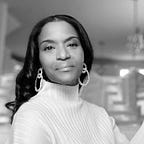How One Brand Started A Beauty Revolution
From makeup to bandages, women of color finally have more choices than ever.
While browsing the aisles at Target recently, I was struck by how different my shopping experience is now, compared to when I was a teenager. Back then, finding certain items at the drugstore often led to frustration and confusion.
I wondered why Band-Aids didn’t match my skin tone; why pantyhose labeled “nude” looked nothing like my bare legs. Why Black haircare products had just one tiny space on the shelf dedicated to them.
And why didn’t any of the makeup match my hue?
Even the “dark” foundations were never dark enough. Although sometimes, you could find a deep shade that was presumably “one-color-fits-all,” but that shade was never even close to being a good fit for me.
Fortunately, things have come a long way. The only question I have now is, what took so long?
Band-Aid didn’t introduce their OURTONE bandages for brown and black skin tones until 2020. And it wasn’t until around the same time that Target began its push to support diversity by increasing their offerings of Black-owned brands.
Thankfully, it didn’t take until the twenty-first century for inclusive makeup companies to come onto the scene.
Cosmetic lines, such as M.A.C., Rihanna’s Fenty Beauty, and the new Wyn Beauty collection by Serena Williams, all cater to a variety of hues. However, they can thank one iconic brand for making space on the shelves.
Beginning in 1973 and for the next two decades, Fashion Fair reigned supreme for Black women. With its signature pink packaging, the cosmetics line was the only company devoted to melanated skin, and it quickly became the go-to choice for Black makeup artists.
Eunice Johnson, co-founder of Johnson Publishing Company-the publisher of Ebony and Jet magazines-launched the department-store brand after she witnessed the models in her annual fashion show (the traveling Ebony Fashion Fair) mixing foundations to create shades that matched their complexions.
For a long time, Fashion Fair’s models and makeup reps were considered royalty in our community. My personal connection with the brand started when my big sister, Yvona, was hired as a regional sales rep in the late 1970s.
I still love to hear her tell the story:
She’d just graduated from Morgan University in Baltimore, and was selected for an executive training program at one of the city’s major department stores. That led to a job as a cosmetics department manager at a large retailer in Philadelphia.
Her success in Philly caught the attention of a Johnson Publishing executive, who asked if she’d be interested in working for Fashion Fair. Naturally, she jumped at the chance.
The company’s co-founder, John Johnson, flew Yvona to Chicago where a waiting limousine whisked her over to the organization’s Michigan Avenue headquarters for an interview with the man himself.
Keep in mind that my sister was only twenty four at the time. She was a ball of nerves. Nevertheless, she held it together and looked the part, that of a confident, beautiful young woman.
As she stepped out of the limo wearing a fabulous outfit, including high heels that required her extra attention to taking every step, she entered the impressive building and was escorted to Mr. Johnson’s office.
At one point during her interview, as Johnson sat in his oversized chair behind his oversized desk that was covered in ostrich leather, with the door to his personal barber shop behind him, he threw down his pen, leaned forward and peered at my sister.
“If I offer you this job, you’d be the youngest sales rep on our staff,” he barked. “Why should I hire you?”
Yvona peered back at him and responded with the first thing that came into her mind: “Because I’m good.”
The rest is history. My sister had an extremely productive career at Fashion Fair, successfully holding down one of the company’s largest regional territories.
What’s more, having a Fashion Fair rep in our family came with perks. Mom, my other sister, and I got tons of free makeup and skincare products.
Even years after Yvona left Fashion Fair, as a professionally trained makeup artist, she graciously did my makeup, as well as my bridesmaids’, on my wedding day (she did the same for our other sister). To this day, Yvona has great skin, and she’s a master at blending and bronzing.
Women who remember Fashion Fair from back in the day, might be surprised to learn that, despite its waning popularity in today’s competitive market, the brand is still around-saved from bankruptcy in 2019 by Desiree Rogers, former social secretary to President and Mrs. Obama.
After her brief stint at the White House, Rogers accepted a high-level position at Johnson Publishing. Along with a business partner, she purchased the flailing Fashion Fair cosmetic line for $1.85 million, modernizing the brand with fresh packaging and healthier ingredients.
I was surprised to discover this myself, and the revelation brought back so many memories. I’ve decided to make my way over to Sephora soon, to check out the new offerings for old times’ sake (the line is also sold at Macy’s).
While the Fashion Fair name harkens back to what seems like a bygone era, it’s no longer your grandmother’s or your mother’s (or even your big sister’s) makeup. And as the first beauty brand to center Black women and all of our magnificent hues, I think it deserves a second look.
Kelly’s debut book, THE WEATHER OFFICER, will be available Summer/Fall 2024.
